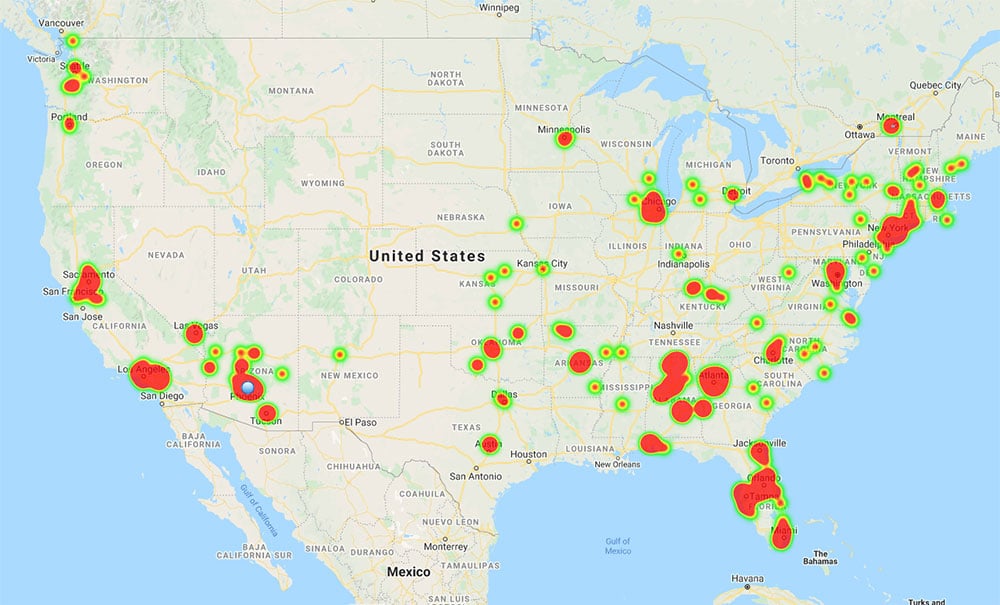Mapping IP Addresses - Geolocation Mapping
Geocode IP addresses on an interactive map to plot the locations of customers, visualize your website visitors, and identify cyber threats. Determine a person’s country of origin, region, city, zip code, and latitude and longitude coordinates from just an IP address.
What is an IP Address?
An Internet Protocol address (IP address) is the unique number given to a device that’s connected to the internet. They’re assigned to every computer, tablet, and smartphone that logs on to a network.
Some devices have static IP addresses that don’t change. However, nowadays most devices use dynamic IP addresses that change depending on the network they’re connected to.
IP addresses serve two main purposes:
- To identify the local network, web server, internet service provider, and domain of the device.
- To identify the physical location of the device.
Since part of an IP address’ job is to find a device’s location, it’s often used along with mapping software to plot the location of the person using that device. This is known as geocoding or IP geolocation.

Why Would You Want to Map an IP Address?
There are a number of reasons why a company or small business would benefit from geocoding IP addresses:
- Plot the Locations of Customers: Depending on your business model you may not have access to your customers’ addresses. However, you might have their IP address. Using this, you can plot the locations of your customers to see where you’re generating sales and where you’re not.
- Plot the Locations of Website Visitors: Similar to plotting customers, you might want to see where most of your web traffic is coming from. Use the IP addresses of your visitors to see where they’re located and discover key insights about your audience.
- Identify Cyber Threats: Plotting the location of IP addresses will also help you spot potential security threats. For example, if you only do business in the US but you notice a number of IP addresses on your site from other areas of the world, you can identify that traffic as suspicious and look into it further.
- Customize Your Analytics Reports: Once you know how to map IP addresses you’re able to create custom analytics reports on your website traffic and users. By moving this process in-house you become less reliant on third-party providers.
Physical addresses aren’t always readily available to you. However, if you do business online you’ll almost always be able to access someone’s IP address, making this a valuable tool for mapping.
How to Geocode IP Addresses
While the process of mapping IP addresses might seem complicated, it’s actually fairly simple:
- Track Your Users’ IP Addresses: Your website won’t automatically track IP addresses, but there are plenty of tools that enable you to do this, such as ipstack. Install one of these tools on your site to begin tracking the IP addresses of all your users.
- Geocode Your IP Addresses: Go into your website visitor logs and copy all the IP addresses you’d like to geocode. Next, you’ll need another tool to convert the addresses into physical locations. IPinfo’s Geolocation API or ipapi’s Bulk IP Lookup Tool work well for this. Enter your IP addresses into your tool of choice to get their physical location.
- Plot the Locations on an Interactive Map: Paste the locations of your IP addresses into Maptive, or upload them from a spreadsheet. Note: Geocoding IP addresses won’t give you a person’s mailing address, but it will provide you with their country, state, city, and zip code.
- Create Your IP Location Map: Click “Create Map” to automatically plot all your IP addresses. Create a link to your map or export your mapping file to easily share it with others.
Coming Mid 2025:
Automatic IP Geocoding from Maptive
While the above process is pretty straightforward, it does require a few extra tools and some configuration. Luckily, Maptive will be introducing a new feature in 2025 to make the process even easier.
You’ll soon be able to enter your IP addresses directly into Maptive and have them automatically plotted on your map. This feature will simplify IP address mapping for your business and save you time.
Stay tuned for an announcement on this exciting new development.
Start Your Free, No Risk, 10 Day Trial
No credit card required. No surprises. Just Results.
START MAPPING NOW